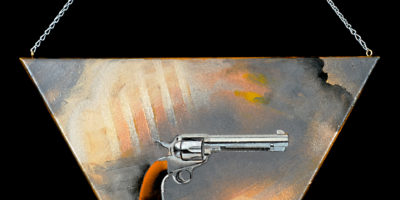Why Does Expressing Violence Feel So Alien to Jews?
My son is not violent but has certain special needs — and I am very aware of how the default strategy for us as parents is to struggle alone, behind the closed doors of one’s apartment instead of seeking help. That’s considered “normal,” that’s what one senses from others as “advisable” — a misplaced kind of “rugged individualism” — and I imagine that if you were to tell people about a violent child, people would recoil and avoid you or the child, or both. And within the Jewish community, mental health conditions are sometimes not given the same urgency as medical conditions. If a kid broke out in a rash, they’d rush him to a dermatologist — but if a kid is violent, they might first wait and see. This hesitation comes from feelings of stigma and shame.
It’s such a shanda for there to be violence in the family; we have this idealized version of ourselves that we hold onto. The Jewish community reflects the community at large, but historically ethnic Jews from Eastern Europe didn’t have the repressed culture and mores of Jews today who are trying to be more “civil.” Partly, it’s the middle- and upper-middle-class expectation that a “proper” person doesn’t express strong emotions, so violence of course is off the charts. A Jewish child is supposed to become a professional, marry, have children and be independent. That expectation, and our community’s competitiveness, feed the denial and shame that many families experience.
The reasons for the stigma against violence in the Jewish community are multi-determined. In Jewish culture we seem to have more room for sadness than for rage. When do you get to express aggression (let alone rage) in Jewish life? At the Pesach seder you ask God to empty His rage and “pour out His wrath against the nations that have known You not” — so you hand it over to Him. I guess there’s beating the willows of the lulav on Hoshanna Rabbah, and drowning out Haman’s name at Purim, but that’s pretty much it. Our general culture is socialized for women to express sadness and men to express anger, so you might say that the Jewish community is socialized to be “women.” I think that this comes from our having been the victims; aggression feels dangerous and out-of-bounds for many reasons, so rather than finding ways to help parents with an aggressive child, many may turn away, both out of fear and out of a sense that this feels deeply unfamiliar to Jews. We’ve been the victims of violence over and over and over, and anything that smells of violence challenges our history as victims, and for some Jews this challenges our narrative.
The last thing we want to be is identified with the aggressor, any kind of aggressor.
And yet, there are profound Jewish resources for dealing with children who appear prone to violence; to name six:
• Community is at the top of the list. We have synagogues, schools, agencies, JCCs, organizations, which can be important partners for education and services.
• Education, since Jews tend to be well-educated and hence somewhat familiar with mental health issues and, indeed, are significant players in the field of mental health.
• Historical survival skills, so there’s a basis for a communal conversation about surviving (and even transforming) violence.
• Teshuvah — repentance and renewal, our commitment to giving people another chance, believing in the possibility of change and growth.
• Torah stories like Cain and Abel, or about Joseph and his brothers, or Simon and Levi — which name the problem and can be a prism for exploration and understanding.
• Chesed — the response of lovingkindness, to care for those who are suffering and help them feel less alone and isolated.
Is the Jewish community doing its job? I don’t think we’re past step one. The first step is to name this issue and not be afraid of it, so that, for example, someone who’s brave enough can post an ad, “I have a Jewish son who’s violent…I need a Jewish circle to talk about it.”
The second step is finding or creating a circle. I know of a shul that has an informal network of people who have found each other; “The Miserable Families Club” gets together, informally, to talk about the challenges in their families. The “Miserable Families” idea is a way to start talking to one another.
The third step is to design supportive programs and services. I know of one rabbi who set up a room off the sanctuary, literally “the sanctuary off of the sanctuary,” for kids who can’t sit still. Rooms like that become spaces to help children appropriately release energy and ultimately to regain control; it helps parents find respite and support; and it helps the synagogue make good on its promise to be “a house of prayer for all people.” (Isaiah 56:7). What could we design for families where there has been aggression and violence from a child? Proverbs 22:6 urges us to take into consideration children’s different paths and profiles in educating them in Torah.
Overall, Jewish families need to know that there is no obligation to endure abuse, and that there is a community to help.
Rabbi Simkha Weintraub is Rabbinic Director of New York’s Jewish Board of Family and Children’s Services.


